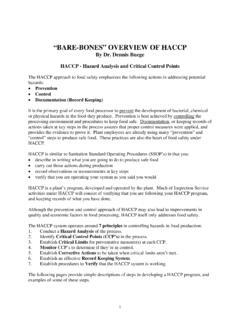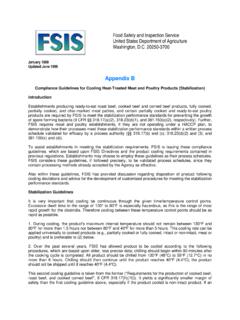Transcription of Guide to Developing a Food Defense Plan for Food ...
1 Adapted from information provided by the Department of Agriculture Food Safety and Inspection Service Guide TO Developing A FOOD Defense plan FOR Food Processing Plants March 2008 BY completing PAGE 11 IN THIS Guide , FOOD PROCESSORS WILL HAVE A FOOD Defense plan FOR THEIR OPERATION Guide to Developing a Food Defense plan for a Food Processing Plant 2 What is Food Defense ? Food Defense is putting measures in place that reduce the chances of the food supply from becoming intentionally contaminated using a variety of chemicals, biological agents or other harmful substances by people who want to do us harm. These agents could include materials that are not naturally-occurring or substances not routinely tested for in food products. A terrorist s goal might be to kill people, disrupt our economy, or ruin your business.
2 Intentional acts generally occur infrequently, can be difficult to detect, and are hard to predict. Food Defense is not the same as food safety. Food safety addresses the accidental contamination of food products during storage and transportation and focuses on biological, chemical or physical hazards. The main types of food safety hazards are microbes, chemicals and foreign objects. Products can become contaminated through negligence and contamination can occur during storage and transportation. Some of the information you will use to create your Food Defense plan will already exist in your Sanitary Standard Operating Procedures (SSOPs), Hazard Analysis and Critical Control Point plan ( haccp ) and other documents relating to emergency response procedures. Make sure to consult these documents for information. There is no need to reinvent the wheel when Developing your Food Defense plan .
3 Why Develop a Food Defense plan ? A Food Defense plan helps you identify steps you can take to minimize the risk that food products in your establishment will be intentionally contaminated or altered. A plan increases preparedness. Although the plan should be in place at all times, it may be particularly helpful during emergencies. During a crisis, when stress is high and response time is at a premium, a documented set of procedures improves your ability to respond quickly. A Food Defense plan will help you maintain a safe working environment for your employees, provide a safe product to your customers, and protect your business. To help owners and operators of food processing plants, we have created this Guide to assist you in Developing a cost-effective Food Defense plan for your facility. This Guide was adapted from USDA guidance for warehouse and distribution center establishments.
4 By using this Guide , you will be able to develop a food Defense plan specific to your facility. Complete page 11 and you will have your plan . Keep in mind that not all of the guidance contained in this document may be appropriate or practical for every plant. We recommend you review the guidance and assess which preventive measures are suitable for your operation. You should determine the most cost-effective way to achieve food Defense goals based on your facility s situation. It is important to remember that there is no one size fits all approach to creating your Food Defense plan . The plan can be as long or as short as is appropriate for your operation. Guide to Developing a Food Defense plan for a Food Processing Plant 3 Who Might Adulterate a Food Product? Below are some examples of the types of individuals who might be motivated to intentionally adulterate food products.
5 You should contact your local law enforcement community for additional information about potential local threats to your facility. Examples of Threats Disgruntled current or former employee Members of terrorist or activist groups posing as: - Cleaning crew - Contractors - Temporary employees - Truck drivers (shipping and receiving) - Visitors - Utility Representatives Individuals that want to intentionally adulterate product and do not have authorized access to your facility are considered intruders. Another threat may come from an internal source, such as disgruntled current or former employees and other insiders, who typically know what procedures are followed in the facility and often know how to bypass many security controls that would detect or delay an outside intruder. Steps in Developing a Food Defense plan We recommend using the following three steps when Developing a Food Defense plan .
6 If you follow and complete these steps and use the forms provided as a template, you will have developed a food Defense plan for your facility. Should you need help using or have questions about this guidance, please contact the FSIS Office of Food Defense and Emergency Response (OFDER) at 866-395-9701. Step 1 Conduct a Food Defense Assessment Begin by choosing a person or team to be responsible for the security of your plant. The team or responsible person will answer the questions in the assessment below to help you understand which parts of your facility may be more vulnerable. When completing this assessment remember to consider both potential internal and external threats. The results of the assessment should be kept confidential so that they do not provide a roadmap for future attacks. To use the following Food Defense Assessment, read each question and check the response that best describes how your business operates.
7 Keep in mind that not all questions will be appropriate for all facilities. If a question does not apply, check N/A . A Yes response for every question is desirable but not expected. A No answer on a question does not necessarily mean there is a serious problem with security at your plant. A No should trigger some thinking about whether additional security measures are needed. Some questions provide a website address for additional information that might help you formulate your plan . Guide to Developing a Food Defense plan for a Food Processing Plant 4 Outside Security 1. What food Defense measures does your plant have in place for the exterior of the building? Yes No N/A Are the facility s grounds secured to prevent entry by unauthorized persons ( , by locked fence, gate or entry/exit doors, guard service)?
8 Is there enough lighting outside the building to properly monitor the plant at night/early morning? Do emergency exits have self-locking doors and/or alarms? 2. Are the following secured with locks, seals, or sensors when unattended (after hours/weekends) to prevent entry by unauthorized persons? Yes No N/A Outside doors and gates? Loading dock doors? Trash compacting chutes? Windows? Roof openings? Vent openings? Trailer (truck) bodies? Truck hatches? Railcars? 3. Does your plant have food Defense procedures for people and/or vehicles entering the facility and/or parking in your lot? Yes No N/A Does the property have a controlled or guarded entrance? Are employee vehicles identified using placards, decals, or some other form of visual identification? Are authorized visitor/guest vehicles identified using placards, decals, or some other form of visual identification?
9 Guide to Developing a Food Defense plan for a Food Processing Plant 5 General Inside Security 4. Does your plant have food Defense measures inside the facility? Yes No N/A Is there an emergency lighting system in the facility? Does your plant have monitored security cameras (CCTV)? Does your building have an emergency alert system that is tested regularly? Are the locations of controls for emergency alert systems clearly marked? Are all restricted areas ( , areas where only authorized employees have access) clearly marked? Are visitors, guests, and other non-employees ( , contractors, salespeople, truck drivers) restricted to non-product areas unless accompanied by an authorized employee? Does local law enforcement (including the fire department) have up-to-date copies of facility layouts/blueprints?
10 Are procedures in place to check toilets, maintenance closets, personal lockers, and storage areas for suspicious packages? Do you regularly take inventory of keys to secured/sensitive areas of the facility? Are ventilation systems constructed in a manner that provides for immediate isolation of contaminated areas or rooms? 5. Are the controls for the following systems or areas restricted ( , by locked door/gate or limiting access to designated employees) to prevent access by unauthorized persons? Yes No N/A Heating, Ventilation, and Air Conditioning systems? Propane Gas? Water systems? Electricity? Refrigeration systems? Volatile chemicals used in refrigeration? Engine/compressor rooms? Ingredient storage areas? Product batching areas 6. Does your facility have food Defense procedures in place for its computer systems?







